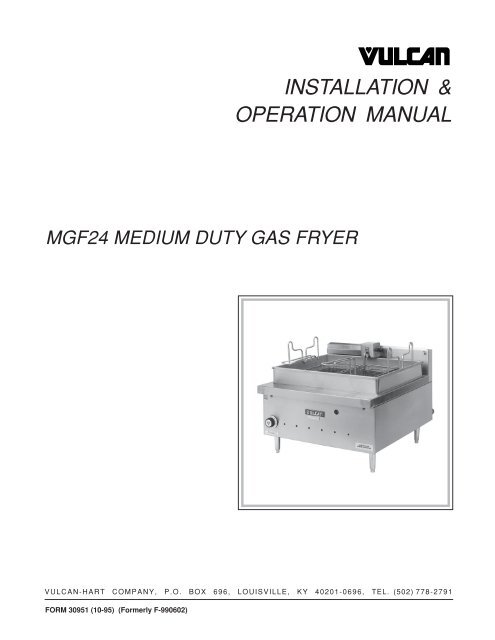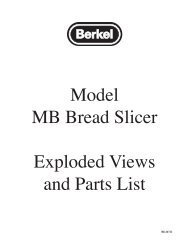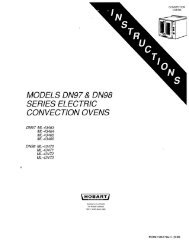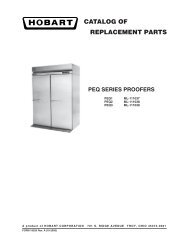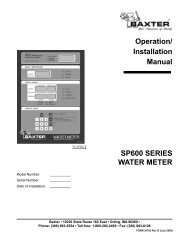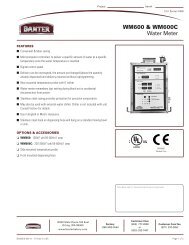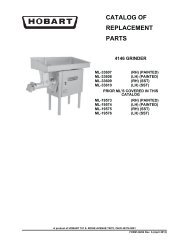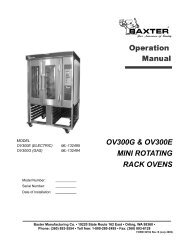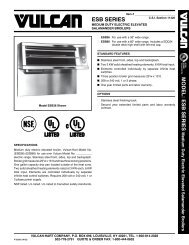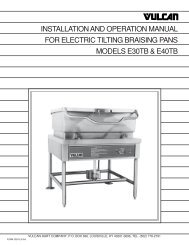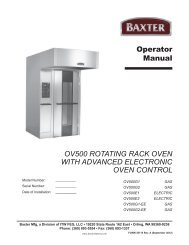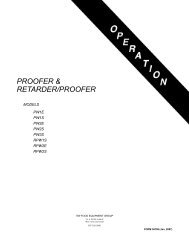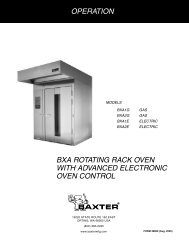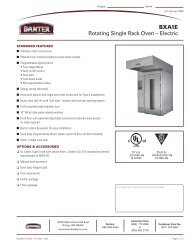INSTALLATION & OPERATION MANUAL
INSTALLATION & OPERATION MANUAL
INSTALLATION & OPERATION MANUAL
You also want an ePaper? Increase the reach of your titles
YUMPU automatically turns print PDFs into web optimized ePapers that Google loves.
<strong>INSTALLATION</strong> &<strong>OPERATION</strong> <strong>MANUAL</strong>MGF24 MEDIUM DUTY GAS FRYERVULCAN-HART COMPANY, P.O. BOX 696, LOUISVILLE, KY 40201-0696, TEL. (502) 778-2791FORM 30951 (10-95) (Formerly F-990602)
IMPORTANT FOR YOUR SAFETYTHIS <strong>MANUAL</strong> HAS BEEN PREPARED FOR PERSONNEL QUALIFIED TO INSTALL GASEQUIPMENT, WHO SHOULD PERFORM THE INITIAL FIELD START-UP ANDADJUSTMENTS OF THE EQUIPMENT COVERED BY THIS <strong>MANUAL</strong>.POST IN A PROMINENT LOCATION THE INSTRUCTIONS TO BE FOLLOWED IN THEEVENT THE SMELL OF GAS IS DETECTED. THIS INFORMATION CAN BE OBTAINEDFROM THE LOCAL GAS SUPPLIER.IMPORTANTIN THE EVENT A GAS ODOR IS DETECTED, SHUTDOWN UNITS AT MAIN SHUTOFF VALVE ANDCONTACT THE LOCAL GAS COMPANY OR GASSUPPLIER FOR SERVICE.FOR YOUR SAFETYDO NOT STORE OR USE GASOLINE OR OTHERFLAMMABLE VAPORS OR LIQUIDS IN THEVICINITY OF THIS OR ANY OTHER APPLIANCE.WARNINGIMPROPER <strong>INSTALLATION</strong>, ADJUSTMENT,ALTERATION, SERVICE OR MAINTENANCE CANCAUSE PROPERTY DAMAGE, INJURY OR DEATH.READ THE <strong>INSTALLATION</strong>, OPERATING ANDMAINTENANCE INSTRUCTIONS THOROUGHLYBEFORE INSTALLING OR SERVICING THISEQUIPMENT.IN THE EVENT OF A POWER FAILURE, DO NOTATTEMPT TO OPERATE THIS DEVICE.— 2 —
TABLE OF CONTENTSGENERAL. . . . . . . . . . . . . . . . . . . . . . . . . . . . . . . . . . . . . . . . . . . . . . . . . . . . . . . . . . . . . . . . . . . . . . 4<strong>INSTALLATION</strong> . . . . . . . . . . . . . . . . . . . . . . . . . . . . . . . . . . . . . . . . . . . . . . . . . . . . . . . . . . . . . . . . . 4Unpacking . . . . . . . . . . . . . . . . . . . . . . . . . . . . . . . . . . . . . . . . . . . . . . . . . . . . . . . . . . . . . . . . 4Location . . . . . . . . . . . . . . . . . . . . . . . . . . . . . . . . . . . . . . . . . . . . . . . . . . . . . . . . . . . . . . . . . 4Installation Codes and Standards . . . . . . . . . . . . . . . . . . . . . . . . . . . . . . . . . . . . . . . . . . . . . 5Assembly . . . . . . . . . . . . . . . . . . . . . . . . . . . . . . . . . . . . . . . . . . . . . . . . . . . . . . . . . . . . . . . . 5Gas Connections . . . . . . . . . . . . . . . . . . . . . . . . . . . . . . . . . . . . . . . . . . . . . . . . . . . . . . . . . . 5Testing the Gas Supply System . . . . . . . . . . . . . . . . . . . . . . . . . . . . . . . . . . . . . . . . . . . . . . 6Leveling the Fryer . . . . . . . . . . . . . . . . . . . . . . . . . . . . . . . . . . . . . . . . . . . . . . . . . . . . . . . . . 6Flue Connections . . . . . . . . . . . . . . . . . . . . . . . . . . . . . . . . . . . . . . . . . . . . . . . . . . . . . . . . . . 6Electrical Connections . . . . . . . . . . . . . . . . . . . . . . . . . . . . . . . . . . . . . . . . . . . . . . . . . . . . . . 6Adjustments . . . . . . . . . . . . . . . . . . . . . . . . . . . . . . . . . . . . . . . . . . . . . . . . . . . . . . . . . . . . . . 7<strong>OPERATION</strong> . . . . . . . . . . . . . . . . . . . . . . . . . . . . . . . . . . . . . . . . . . . . . . . . . . . . . . . . . . . . . . . . . . . 9Controls . . . . . . . . . . . . . . . . . . . . . . . . . . . . . . . . . . . . . . . . . . . . . . . . . . . . . . . . . . . . . . . . . 9Before First Use . . . . . . . . . . . . . . . . . . . . . . . . . . . . . . . . . . . . . . . . . . . . . . . . . . . . . . . . . . . 9Lighting the Pilot . . . . . . . . . . . . . . . . . . . . . . . . . . . . . . . . . . . . . . . . . . . . . . . . . . . . . . . . . . 9Adding Frying Compound . . . . . . . . . . . . . . . . . . . . . . . . . . . . . . . . . . . . . . . . . . . . . . . . . . 10Turning the Fryer On . . . . . . . . . . . . . . . . . . . . . . . . . . . . . . . . . . . . . . . . . . . . . . . . . . . . . . 10Turning the Fryer OFF . . . . . . . . . . . . . . . . . . . . . . . . . . . . . . . . . . . . . . . . . . . . . . . . . . . . . 10High Limit Device . . . . . . . . . . . . . . . . . . . . . . . . . . . . . . . . . . . . . . . . . . . . . . . . . . . . . . . . . 10Cleaning . . . . . . . . . . . . . . . . . . . . . . . . . . . . . . . . . . . . . . . . . . . . . . . . . . . . . . . . . . . . . . . . 10Frying Compound Maintenance . . . . . . . . . . . . . . . . . . . . . . . . . . . . . . . . . . . . . . . . . . . . . 12Suggested Time and Temperature Chart for Deep Fat Frying . . . . . . . . . . . . . . . . . . . . . 13MAINTENANCE . . . . . . . . . . . . . . . . . . . . . . . . . . . . . . . . . . . . . . . . . . . . . . . . . . . . . . . . . . . . . . . . 14Vent . . . . . . . . . . . . . . . . . . . . . . . . . . . . . . . . . . . . . . . . . . . . . . . . . . . . . . . . . . . . . . . . . . . . 14Service and Parts Information . . . . . . . . . . . . . . . . . . . . . . . . . . . . . . . . . . . . . . . . . . . . . . . 14DEEP FRYING TROUBLESHOOTING GUIDE . . . . . . . . . . . . . . . . . . . . . . . . . . . . . . . . . . . . . . . 15— 3 —
Installation, Operation and Care ofMODEL MGF24 GAS FRYERPLEASE KEEP THIS <strong>MANUAL</strong> FOR FUTURE USEGENERALVulcan fryers are produced with quality workmanship and material. Proper installation, usage andmaintenance of your fryer will result in many years of satisfactory performance.It is suggested that you thoroughly read this entire manual and carefully follow all of the instructionsprovided.<strong>INSTALLATION</strong>The fryer must be restrained with adequate ties to prevent tipping when installed in order to avoid thesplashing of hot liquid.UNPACKINGThis fryer was inspected before leaving the factory. The transportation company assumes fullresponsibility for safe delivery upon acceptance of the shipment. Immediately after unpacking, checkfor possible shipping damage. If the fryer is found to be damaged, save the packaging material andcontact the carrier within 15 days of delivery.Carefully unpack fryer and place in a work-accessible area as near to its final installed position aspossible. Remove the packing bag containing the adjustable legs from inside the carton.Before installing,verify that the electrical service and type of gas supply (natural or propane) agree withthe specifications on the rating plate located on the inside of the front panel. If the supply andequipment requirements do not agree, do not proceed with the installation. Contact your dealer orVulcan-Hart Company immediately.LOCATIONThe equipment area must be kept free and clear of combustible substances. This fryer is for use onlyin locations adjacent to non-combustible construction.— 4 —
When installed, minimum clearance from combustible and non-combustible construction must be 6"at the sides and 6" at the rear. There must be at least 16" clearance between the fryer and any opentop flame units. The fryer may be installed on combustible floors.The installation location must allow adequate clearances for servicing and proper operation. Aminimum front clearance of 36" is required.Do not obstruct the flow of combustion and ventilation air. Adequate clearance for air openings intothe combustion chamber must be provided. Make sure there is an adequate supply of air in the roomto replace air taken out by the ventilating system. This will prevent fryer function from being affectedby a reduced atmospheric pressure.Do not permit fans to blow directly at the fryer. Wherever possible, avoid open windows next to thesides or back of the fryer. Avoid wall-type fans which create air cross currents within the room.<strong>INSTALLATION</strong> CODES AND STANDARDSThe fryer must be installed in accordance with:1. State and local codes.2. National Fuel Gas Code, ANSI-Z223.1 (latest edition). Copies may be obtained from The AmericanGas Associaton, Inc., 1515 Wilson Blvd., Arlington, VA 22209.3. National Electrical Code, ANSI/NFPA-70 (latest edition). Copies may be obtained from TheNational Fire Protection Association, Batterymarch Park, Quincy, MA 02269.ASSEMBLYScrew the legs into the permanently fastened nuts on four corners of the fryer bottom. Tighten the legsand set the fryer in place. CAUTION: Do not slide fryer with legs mounted. If it is necessary tomove the fryer, allow it to cool, then lift it.GAS CONNECTIONSCAUTION: All gas supply connections and any pipe joint compound used must be resistant tothe action of propane gases.All fryers are equipped with fixed orifices for use with either natural or propane gas, as ordered, andno adjustment is necessary.Fryers for operation on natural or propane gas must have a pressure regulator with an outlet pressureof 4" Water Column for natural gas supply, and 10.0" Water Column for propane gas supply. Thesepressure regulators are available from Vulcan-Hart.Codes require that a gas shutoff valve be installed in the gas line ahead of the fryer.— 5 —
Connect gas supply to the fryer. The gas supply line must be at least the equivalent of 3 /4" iron pipe.Make sure the pipes are clean and free of obstructions, dirt, and piping compound.Hold the gas inlet pipe (in front of the manual valve) tight when making connections to prevent pressureregulator from rotating and damaging internal tubing connections.WARNING: PRIOR TO LIGHTING, CHECK ALL JOINTS IN THE GAS SUPPLY LINE FOR LEAKS.USE SOAP AND WATER SOLUTION. DO NOT USE AN OPEN FLAME.After piping has been checked for leaks, fully purge all piping receiving gas to remove air.TESTING THE GAS SUPPLY SYSTEMWhen test pressures exceed 1 /2 psig (3.45 kPa), the fryer and its individual shutoff valve must bedisconnected from the gas supply piping system.When test pressures are 1 /2 psig (3.45 kPa) or less, the fryer must be isolated from the gas supplysystem by closing its individual manual shutoff valve.LEVELING THE FRYEROnce gas connections have been made, place a spirit level on top of the fryer. Turn the adjustmentscrew at the bottom of each leg until the fryer is level front-to-back and side-to-side.FLUE CONNECTIONSAdequate ventilation should be provided by a hood with vent and exhaust fan. Never make flueconnections directly to the fryer. A minimum clearance of 18" must be maintained from the terminationof the flue vent to the filters of the hood venting system.Do not obstruct the flow of flue gases from the flue duct located on the rear of the fryer. It isrecommended that the flue gases be ventilated to the outside of the building through a ventilationsystem installed by qualified personnel.Information on the construction and installation of ventilating hoods may be obtained from the"Standard for Removal of Vapors from Commercial Cooking Equipment," NFPA #96 (latest edition),available from the National Fire Protection Association, Batterymarch Park, Quincy, MA 02269.ELECTRICAL CONNECTIONSWARNING: ELECTRICAL AND GROUNDING CONNECTIONS MUST COMPLY WITH THEAPPLICABLE PORTIONS OF THE NATIONAL ELECTRICAL CODE AND/OR OTHER LOCALELECTRICAL CODES.— 6 —
WARNING: APPLIANCES EQUIPPED WITH A FLEXIBLE ELECTRIC SUPPLY CORD AREPROVIDED WITH A THREE-PRONG GROUNDING PLUG. IT IS IMPERATIVE THAT THISPLUG BE CONNECTED INTO A PROPERLY GROUNDED THREE-PRONG RECEPTACLE. IFTHE RECEPTACLE IS NOT THE PROPER GROUNDING TYPE, CONTACT AN ELECTRICIAN.DO NOT REMOVE THE GROUNDING PRONG FROM THIS PLUG.A 120-volt, 3-wire, 60 Hz. supply cord is supplied at the rear of the fryer.Do not connect the fryer to electrical supply until after gas connections have been made.An electrical diagram is located on the inside of the front panel.ADJUSTMENTSTo Open Front Panel1. Remove control knob by grasping the outer edge of the knob and pulling it straight out, withouttwisting or turning.2. Turn quick connect fasteners 1 /4 turn counterclockwise.3. Pull the top edge of the front panel to open.Reverse the procedure to close the front panel.Main Burner Air SupplyFor efficient burner operation, it is important that a proper balance of gas volume and primary air supplyis maintained, resulting in complete combustion. Insufficient air supply results in a yellow streamingflame. Primary air supply is controlled by an air shutter on the front of the burner.Loosen the hexagonal head screw on front of the burner. Adjust the air shutter to just eliminate yellowtips of burner flame. Lock the air shutter in place by tightening the screws. Repeat this procedure withall burners.Pilot FlameTo adjust the pilot flame, remove the pilot adjustment cap to expose the adjusting screw (Fig. 1). Rotatethe adjusting screw clockwise to reduce the gas flow and counterclockwise to increase the gas flowto provide a properly sized pilot flame (approximately 1 /2" to 3 /4" long). Replace adjustment cap.— 7 —
Fig. 1— 8 —
<strong>OPERATION</strong>WARNING: HOT OIL AND PARTS CAN CAUSE BURNS. USE CARE WHEN OPERATING,CLEANING AND SERVICING THE FRYER.WARNING: SPILLING HOT OIL CAN CAUSE SEVERE BURNS. DO NOT MOVE FRYER WITHOUTDRAINING ALL OIL FROM THE TANK.CONTROLSIndicating Light — When lit, indicates that thermostat is calling for gas to the burners.Thermostat — Maintains temperature of oil in tank.BEFORE FIRST USECleaningUsing a non-corrosive, grease-dissolving commercial cleaner, clean the protective metal oils from allsurface parts and the fry tank interior. Follow the cleaner manufacturer's directions. To empty fry tank,grasp the black handle on the pivotal head above the fry tank and swing it to the left of the fryer untilit stops. Firmly grasp both handles of the fry tank and lift it out. Rinse thoroughly and drain. Be sureto remove all traces of cleaner; it can affect the food taste. Wipe fry tank completely dry with a soft cleancloth.Clean all fryer accessories. Rinse all parts thoroughly and wipe dry.SeasoningLight seasoning of the backsplash area is required to avoid possible surface corrosion. With a soft,lint-free cloth, apply a thin layer of cooking oil over entire backsplash area. This should also be doneafter every cleaning.LIGHTING THE PILOTLighting instructions are also inside the front panel.1. Turn main gas supply ON.2. Turn thermostat control knob to the OFF position.3. Wait for five minutes, then depress the red button on the shutoff valve (see Fig. 1) and light pilotthrough the observation hole in the front panel. Keep red button depressed for one minute afterlighting.4. If the pilot does not stay lit, repeat Step 3.— 9 —
ADDING FRYING COMPOUNDFill fry tank to the FULL mark (approximately 30 pounds) with liquid or solid frying compound. Do notoverfill. When using solid frying compound, set the thermostat at 200°F and allow compound to liquify,then adjust compound level.Do not allow frying compound level to drop below the ADD mark. For proper operation of the fryer andgood frying results, the frying level should be maintained between the FULL and the ADD marks.TURNING THE FRYER ONCAUTION: Before turning the burners on, the fry tank must be filled with liquid fryingcompound. If this is not done, the tank walls can be damaged. Warpage can cause leaks.All burners are lit from constantly burning pilots. Turn thermostat control knob to desired temperatureto put fryer in operation.TURNING THE FRYER OFFTemporary ShutdownTurn thermostat to OFF position.Seasonal ShutdownTurn thermostat to OFF position. Turn gas shutoff valve OFF.HIGH LIMIT DEVICEA high limit device will shut the fryer down if the oil overheats. DO NOT relight pilot until oil temperaturehas lowered to at least 350°F. If the situation persists, contact your local Vulcan-Hart authorizedservicer.CLEANINGWARNING: DISCONNECT ELECTRICAL POWER SUPPLY BEFORE CLEANING.CAUTION: Do not spray with hose or steam cleaner. Doing so will cause extensive damage (notcovered under warranty).DailyClean your fryer regularly. If regular cleaning is neglected, grease will be burned on and discolorationsmay form. These may be removed by washing with any detergent or soap and water. Particularlystubborn discolorations may be removed with a self-soaping scouring pad or a paste made of waterand a mild scouring powder applied with a plastic open pad or sponge. Do not use standard steel woolon stainless steel finishes. Pieces of the steel wool will adhere to the stainless steel and cause rusting.— 10 —
Clean all stainless steel surfaces with a damp cloth and polish with a soft dry cloth. A non-abrasivecleaner may be used to remove discolorations. Always rub in the direction of the polish lines on thestainless steel to preserve the original finish. To prevent water spots and streaks, rinse equipmentthoroughly with warm water and wipe dry with a soft clean cloth. The addition of a rinsing agent willalso help prevent spotting.Keeping the fryer exterior clean and free of accumulated grease will prevent stubborn stains fromforming. Wash all exterior surfaces at least once daily. Use a cloth with warm water and a mild soapor detergent. Follow with a clear rinse, then dry.Weekly or as RequiredThe frequency of cleaning depends on the load conditions. Set a definite cleaning schedulecorresponding to how much the fryer is used. Cleaning should be done at least once a week.1. Turn the thermostat to OFF and allow tank to cool.2. Remove the fry baskets.3. Grasp the black handle on the pivotal head above the fry tank and swing it to the left of the fryeruntil it stops.4. Remove the crumb tray.5. Firmly grasp both handles of the fry tank and lift it out.6. Strain the frying compound into a clean container.7. Replace the empty fry tank and lower the pivotal head to place thermostat bulbs inside the tank.8. Add water to the FULL mark on the tank.9. Add any good grade of cleaner. Follow the cleaner manufacturer's instructions.10. Turn the thermostat to 250°F and bring the solution to a boil. Boil long enough to loosen or dissolveall "varnish" or "carbon" deposits (approximately 30 minutes).11. Turn fryer OFF. Lift the pivotal head.12. If necessary, clean the thermostat bulbs, using a long handled fiber or plastic brush and mild soapsolution.13. Rinse with clean water to remove all cleaning mixture.14. Lift out the fry tank and drain. Wash fry tank again with a mild soap solution. Rinse with clean waterto remove all cleaning mixture. The fry tank must be thoroughly rinsed; even a trace of cleanerleft inside the tank will ruin frying compound.15. Rinse inside of tank with 2 cups of vinegar. Rinse with clean water until vinegar odor is gone.— 11 —
16. Dry thoroughly. Replace the tank and lower the pivotal head.17. Cover tank until ready for use.18. Keep burner air shutter openings clean.19. Keep main burner ports clean. To clean burners, boil them in a strong solution of lye water for 15minutes. Then, either brush or clean gas ports with a sharp pointed metal instrument to ensureopen ports.FingerprintsFingerprints are sometimes a problem on highly polished surfaces of stainless steel. They can beminimized by applying a cleaner that will leave a thin, oily or waxy film. Wipe cleaner on and removeexcess with a soft dry cloth. After using, subsequent fingerprints will usually disappear when wipedlightly with a soft cloth containing a little of the cleaner. If the surface is especially dirty to start with,wash first with soap or detergent and water.Burned On Foods and GreaseSoaking with hot soapy water will help greatly to remove burned on foods and grease. Stubborndeposits can be removed with scouring powder mixed into a paste and applied with stainless steel woolor sponges.PrecautionsWhen scraping off heavy deposits of grease or oil from stainless steel equipment, never use ordinarysteel scrapers or knives. Particles of ordinary steel may become embedded in, or lodge on, the surfaceof the stainless steel. These will rust, causing unsightly stains. Where it is necessary to scrape, usestainless steel, wood, plastic, or rubber tools, or stainless steel wool.FRYING COMPOUND MAINTENANCEFrying compound life may be extended by following these procedures:• Do not salt foods over the fryer.• Use good quality frying compound.• Filter frying compound daily at a minimum.• Replace frying compound if it becomes poorly flavored.• Keep equipment and surroundings clean.• Set thermostats correctly. Do not use excessively high temperatures.• Remove excess moisture and particles from food products before placing in fryer.• Dip out several cups of frying compound from the fry tank every day and add fresh frying compoundto replace it.— 12 —
SUGGESTED TIME AND TEMPERATURE CHARTFOR DEEP FAT FRYINGFood Temp. °F Time (minutes)DOUGHNUTSCake type 375 1 1 /2 to 2Yeast raised 375 2 to 2 1 /2MEATCutlets (less than 1 /2" thick) 350 5 to 8Chicken fried steak 350 5 to 8Chops (very lean) 350 5 to 8MISCELLANEOUSChinese noodles 375 1 to 2Croquettes 350 2 to 3French toast 350 2 to 3Glazed cinnamon apples 300 5 to 10French fried sandwiches 350 1 to 2POULTRYChicken (large pieces) 325 10 to 15Chicken (small pieces) 350 7 to 10Chicken (pre-cooked) 325 - 350 3 to 5Turkey (small pieces) 325 9 to 10SEAFOODFish cakes 350 2 to 3Clams 350 1 to 3Fillets (small) 350 3 to 5Oysters 350 2 to 5Scallops 350 3 to 5Shrimp 350 4 to 6Smelts 350 4 to 6VEGETABLESEggplant 350 5 to 7Onion rings 350 3 to 5Potatoes ( 1 /2" strips, one-operation) 350 6 to 9Potatoes (blanch) 350 4 to 6Potatoes (brown) 350 2 to 3Potatoes (Julienne) 350 3 to 5— 13 —
MAINTENANCEWARNING: HOT OIL AND PARTS CAN CAUSE BURNS. USE CARE WHEN OPERATING,CLEANING AND SERVICING THE FRYER.WARNING: SPILLING HOT OIL CAN CAUSE SEVERE BURNS. DO NOT MOVE FRYER WITHOUTDRAINING ALL OIL FROM THE TANK.WARNING: DISCONNECT ELECTRICAL POWER SUPPLY BEFORE PERFORMING ANYMAINTENANCE.VENTAnnually, when the fryer is cool, check the flue and clear any obstructions.SERVICE AND PARTS INFORMATIONTo obtain service and parts information concerning this fryer, contact the Vulcan-Hart Service Depotin your area (refer to listing supplied with the fryer), or Vulcan-Hart Company Service Department atthe address or phone number shown on the front cover of this manual.— 14 —
DEEP FRYING TROUBLESHOOTING GUIDE— 15 —
FORM 30951 (10-95) (Formerly F-990602)— 16 —PRINTED IN U.S.A.


